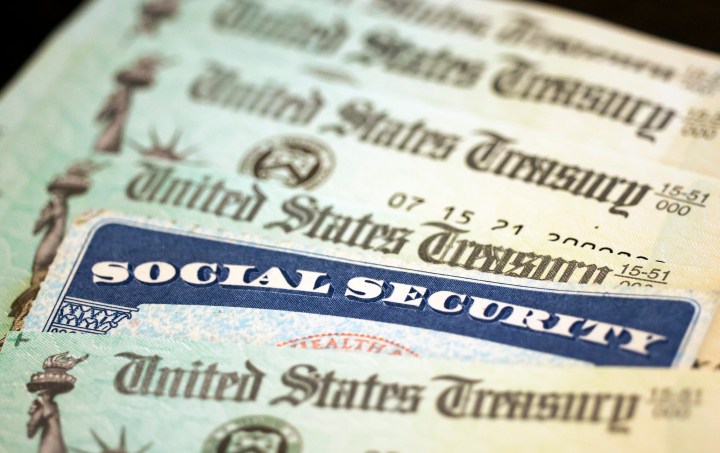
Will we ever run out of Social Security numbers?

This is just one of the stories from our “I’ve Always Wondered” series, where we tackle all of your questions about the world of business, no matter how big or small. Ever wondered if recycling is worth it? Or how store brands stack up against name brands? Check out more from the series here.
Listener Pamela Dixon from Fort Smith, Arkansas, asks:
With just 9 digits and millions of people, how do they keep coming up with new Social Security numbers? Do they reuse deceased people’s Social Security numbers?
There are, theoretically, 1 billion possible Social Security number combinations.
This all-important nine-digit figure, first issued in 1936, enables you to receive disability and retirement benefits, apply for a driver’s license in many states, file your income taxes (with some exceptions) and much more.
While the U.S. is the third-most-populous country on Earth, the Social Security Administration told Marketplace over email that it has assigned about 531 million Social Security numbers as of this month. The spokesperson added that there are still about 358 million numbers left to assign, and those are expected to last for approximately the next 70 years.
So we’re not in danger of running out of them anytime soon, and your number is yours to keep. Forever. An FAQ on the agency’s website says it will not reassign your number even after you die.
As for what the SSA will do when we finally use them up, even if that’s almost a century away? “The agency will address this issue in the future,” the spokesperson said.
Despite the availability of so many combinations, there have been limits on how these digits were issued, which is why the administration changed the way it assigns numbers back in 2011.
How SSNs used to be assigned
Before 2011, the first three digits of a person’s Social Security number (also known as the area number) had geographic significance.
Specific numbers were assigned to states. The administration, for example, allotted 540-544 to Oregon, 318-361 to Illinois and 159-211 to Pennsylvania. Some states actually ran out of their allotments, like Florida in 1980, and were given a new range of numbers to use.
In the early 1970s, the SSA began issuing Social Security numbers from its Baltimore headquarters. Previously, they were assigned by local offices around the country. Since the early 1970s, the first three digits, those area numbers, were based on the ZIP code of your mailing address.
But before the ‘70s, when local offices issued Social Security cards, the area number signified the state where the office was located. “This did not necessarily have to be the State where the applicant lived, since a person could apply for their card in any Social Security office,” according to the agency’s website.
Before 1963, some numbers were even designated for specific groups of employees, with the Railroad Retirement Board assigning Social Security numbers starting with the digits 700-728 to railroad workers.
A larger pool of numbers to assign
In 2011, the SSA stopped allocating those first three digits, or the area number, based on your address, and said it would allocate some area numbers that had gone unassigned, including all of those that start with 7 or 8.
These changes were aimed at increasing the pool of available numbers and reducing identity theft.
Social Security numbers also include group numbers — those two digits in the middle — which has helped the agency break down the area numbers into subgroups. The SSA began doing this when numbers were first issued, before the advent of computers, because it needed a way to organize these numbers in filing cabinets.
“So, for example, for area numbers starting with 527 there would be 99 subgroups, one for every number starting with 527-01, and one for every number starting with 527-02, and so on,” the SSA website explains.
While there are 1 billion available combinations for a 9-digit number, the SSA does have restrictions. It says it won’t issue numbers that begin with 000, 666 or 900-999, have the 00 in the group position (i.e., the middle) or end with 0000. Those four digits that complete your SSN, which are its own unit, are known as the serial number.
As to why it won’t issue these numbers, the agency wouldn’t say. “In order to maintain the security and integrity of the SSN, we cannot discuss further,” the spokesperson explained.
But for an area number like 666, you can imagine that it would catch hell if it did.
Back in 1996, California couple Eric and Maria Bessem complained that their daughter was given that number, which in Christianity is considered the “biblical mark of the beast,” The Orange County Register reported. (However, the article doesn’t note what position these digits were in.)
“If it were a lottery number, I could care less, but this is something that is very personal, something she will have for 85 years,” said Maria Bessem. “According to the Bible, Christians are supposed to refuse the mark of the beast.”
Excluding figures like 9 can help differentiate SSNs from other numbers, like the Taxpayer Identification Number, which always starts with a 9. This identifier is granted to individuals, like undocumented immigrants, who aren’t eligible for Social Security numbers.
There’s a lot happening in the world. Through it all, Marketplace is here for you.
You rely on Marketplace to break down the world’s events and tell you how it affects you in a fact-based, approachable way. We rely on your financial support to keep making that possible.
Your donation today powers the independent journalism that you rely on. For just $5/month, you can help sustain Marketplace so we can keep reporting on the things that matter to you.












